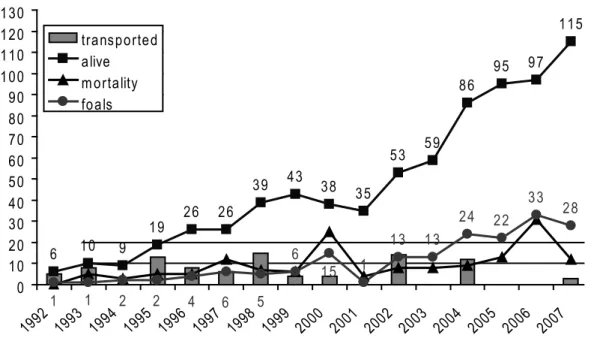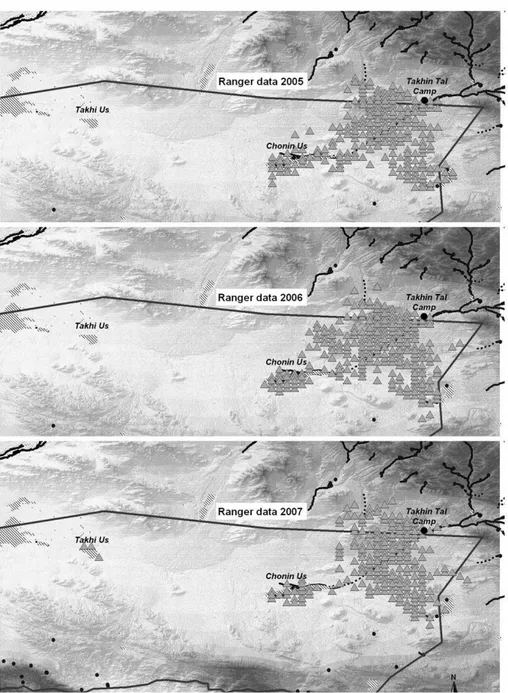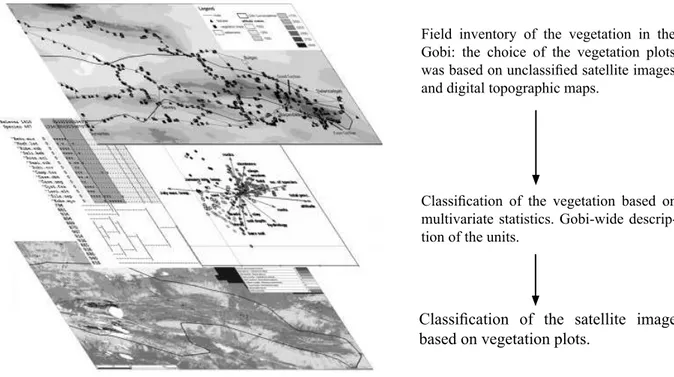13
Przewalski’s Horse (Equus ferus przewalskii) Re-introduction in
the Great Gobi B Strictly Protected Area: from Species to Ecosystem
Conservation
P. Kaczensky
1*, O. Ganbaatar
2,3, H. von Wehrden
1,4, N. Enksaikhan
5,
D. Lkhagvasuren
3, and C. Walzer
11Research Institute of Wildlife Ecology, University of Veterinary Medicine, Vienna Savoyenstrasse 1, A-1160
Vienna, Austria, E-mail: petra.kaczensky@vu-wien.ac.at & chris.walzer@vu-wien.ac.at; *corresponding author
2Great Gobi B SPA Administration, Takhiin Tal, Mongolia, E-mail: ganbaatar_o@yahoo.com 3Department of Zoology, Faculty of Biology, National University of Mongolia, Ulaanbaatar 210646, E-mail:
Lkhagvasuren@biology.num.edu.mn
4University of Halle,Department of Geobotany and Botanical Garden, Am Kirchtor 1, 06108 Halle/Saale,
German, E-mail:HenrikvonWehrden@web.de
5International Takhi Group, Ulaanbaatar, Mongolia, E-mail: itgmon@gmail.com
Abstract
The Przewalski’s horse (Equus ferus przewalskii Poljakov, 1881), or “Takhi” in Mongolian, became extinct in the wild by the mid 1960’s. The last recorded sightings of Przewalski’s horses occurred in the Dzungarian Gobi desert in SW Mongolia, today’s Great Gobi B Strictly Protected Area (SPA). A re-introduction program was initiated in 1992 and the ! rst group of captive-born Przewalski’s horses was airlifted to the SPA. Given the logistical challenges associated with such a venture, the initial project focus has been on transport logistics and the well-being of the re-introduced horses. Today, conservation efforts are spread over the entire protected area. Present day efforts include other mammals, vegetation and the local people. Due to its important symbolic value in Mongolian culture, the Przewalski’s horse became an important " agship species for the protected area’s conservation and management.
Key words: Equus ferus przewalskii, conservation, management, Mongolia, re-introduction
Introduction
The Przewalski’s horse (Equus ferus przewalskii Poljakov, 1881), called “Takhi” in Mongolian, became extinct in the wild and has only survived due to captive breeding (Wake! eld et al., 2002). The last recorded sightings of the Przewalski horse in the wild occurred in the mid 1960’s in the Dzungarian Gobi of Mongolia (Sokolov & Orlov, 1986). Thereafter, the species survived only due to captive breeding based on 13 founder animals (Wake! eld et al., 2002). The reasons for the extinction of the Przewalski’s horse were seen in the combined effects of pasture competition with livestock and over-hunting.
In the 1975 the Dzungarian Gobi was declared as part B of the Great Gobi Strictly Protected Area (SPA). By the mid of 1980’s the captive Przewalski’s horse population had grown to over 1,000 individuals Ÿ an important pre-requisite to initiating a re-introduction program. With Mongolia’s independence, a private fund and the
Mongolian Society for the Conservation of Rare Animals initiated the “Takhiin Tal” project with the support of various international sponsors (Kaczensky et al., 2004).
In 1992 the ! rst group of captive born Przewalski’s horses was airlifted to Takhiin Tal at the edge of the 9,000 km2 GreatGobi B SPA.
In 1997 the ! rst harem group was released into the wild from the adaptation enclosures, and 1999 the ! rst foals were successfully raised in the wild (Slotta-Bachmayr et al., 2004).
International criticism and recommendations (Van Dierendonck & Wallis de Vries, 1996) resulted in the establishment of the International Takhi Group (ITG) in 1999 with the aim to continue and extend the Takhiin Tal project in accordance with the IUCN re-introduction guidelines. Today the Takhiin Tal project receives international recognition and although it is still too early to judge whether the project is a success or failure, the positive trend of the free-ranging Przewalski’s horse population is encouraging (Fig. 1). However,
Kaczensky et al. From species to ecosystem conservation 14
for the successful implementation of this re-introduction program it needs to be embedded in a broader context of ecosystem conservation. Hereunder we would like to describe how and why the project, which started as a single-species re-introduction was greatly expanded in recent years.
Infrastructure
International transports from Europe to Mongolia were both a logistic and a ! nancial challenge. Therefore, initial re-introduction efforts were focused on well-being of the Przewalski’s horses in and around the adaptation enclosures (Robert et al., 2005). However, the establishment of a permanent ! eld station with the necessary infrastructure (solar power, laboratory, of! ce with EDV, vehicles and petrol), and communication abilities (VHF communication, satellite-based email and phone) proved equally important.
In 2004 the Takhiin Tal camp hosted the 2nd
International workshop on the re-introduction of the Przewalski’s horse. In 2005 facilities at the Takhiin Tal camp were further upgraded with the construction of the Great Gobi B SPA park headquarters funded in part by the Austrian Ministry of Environment. Facilities at the Takhiin Tal camp now allow year-round living and working space. The camp provides training possibilities for young Mongolian biologists, has created local
employment options and is run by well-trained and motivated local staff (see www.takhi.org).
Monitoring
Monitoring is a key element of any re-introduction project. In the Great Gobi B SPA monitoring has employed standardized methods since 2002 with a focus on: (1) population dynamics and distribution of re-introduced Przewalski’s horses, (2) distribution of wild and domestic ungulates and (3) human impacts on the protected area.
Park rangers are able to identify individual Przewalski’s horses and check their groups 2-3 times a week (Ganbaatar, 2003). They determine the location of individual Przewalski’s horse and groups based on a raster map, note group size and composition, and protocol any peculiarities of individual horses (e.g. injuries, poor body condition etc.). The data is fed into a central database, and all data on population dynamics and group composition are passed onto the European Endangered Species (EEP) coordinator for annual reporting. As of December 2007 the Przewalski’s horse population in Takhiin Tal had increased up to 115 individuals (Fig. 2).
Range use of the re-introduced Przewalski’s horse population increased gradually and pasture use was largely con! ned to the north-eastern corner of the protected area (Fig. 2). In 2005 one
6 1 0 9
1 9
2 6 2 6
3 9 4 3 3 8 3 5
5 3 5 9 8 6
9 5 9 7 1 1 5
6
1
1 3 1 3
2 4 2 2 3 3
2 8
5 6 4 2 2 1 1
1 5
0 1 0 2 0 3 0 4 0 5 0 6 0 7 0 8 0 9 0 1 0 0 1 1 0 1 2 0 1 3 0
1992 1993 1994 1995 1996 1997 1998 1999 2000 2001 2002 2003 2004 2005 2006 2007 tra nsp o rte d
a live m o rta lity fo a ls
Figure 1. Population development of the Przewalski’s horse population in the Great Gobi B SPA in south-western Mongolia. [For total population see numbers above graph” total population”, for number of foals see numbers below and above graph “foals”. Years refer to “horse years” from birth in May to the
harem group was released at Takhiin Us water point about 120 km west of the Takhiin Tal camp to speed up the expansion of the distribution range. To facilitate monitoring and to gain sound data on habitat and space use, 10 individuals of Przewalski’s horses were monitored with satellite collars (Kaczensky et al., 2008). Range sizes based on telemetry differed only marginally from those determined by the ranger observational data. In Takhiin Tal the individual horse groups cover non-exclusive home ranges of 152-826 km² (Kaczensky et al., 2007; Kaczensky et al., 2008). Adaptation of newly released Przewalski’s horses was also monitored through behavioural
observations of selected groups (Souris et al., 2007).
Wildlife surveys are conducted on a monthly basis, alternating between the small surveys covering the north-western part of the park (4,000 km²) with an entire park (9,000 km²) assessment in the following month. During these surveys all wildlife and livestock seen from ! xed transects are counted and mapped, thus providing qualitative data on ungulate distribution (Kaczensky et al., 2007). The surveys are also an excellent opportunity to meet local herders and patrol for illegal actions such as poaching or saxaul (Haloxylon sp.) collection.
Kaczensky et al. From species to ecosystem conservation 16
Additional monitoring data are obtained via interviews or questionnaires, mainly focusing on livestock numbers and herder camp positions (Kaczensky et al., 2007), wolf (Canis lupus) predation on livestock (Enkhsaikhan 2002) and wolf harvest data (Kaczensky et al., 2008 in press).
Inventories
The Great Gobi B SPA connects the Aralo-Caspian with the central Asian region and thus shows a mixture of " oral elements which makes it rather unique within Mongolia (von Wehrden et al., 2006a). In order to map plant biodiversity and vegetation types as a basis for habitat analysis studies, vegetation of the entire Great Gobi B SPA and its surroundings was mapped using a combination of ground surveys, multivariate statistics and remote sensing tools (Figure 3; von Wehrden et al. 2006b).
Other inventories within the Great Gobi B SPA focused on small mammals (Lkhagvasuren, 2004a) and an initial bat study (Lkhagvasuren, 2004b).
Speci! c research projects
Besides the establishment of basic infrastructure, basic monitoring (designed to provide long-term data) and inventories (designed to derive baseline data), several short- and
mid-term research projects were initiated. In respect to wildlife, one research focus is on the spatial organization and habitat use of the Asiatic wild ass (Equus hemionus) and another is on habitat use and feeding ecology of the grey wolf.
Socioeconomic projects
Another focus is drawn on socioeconomic aspects of local people, their impact on the park and its surrounding (IPECON / NZNI 2003), and their attitude toward wildlife and management issues (Enkhsaikhan, 2002; Kaczensky, 2007). In 2005 training workshops on the construction and application of fuel ef! cient stoves were conducted in order to reduce the pressure for illegal saxaul and juniper collection. In 2006 a concept for environmental education for children in Takhiin Tal was developed, yet still needs to be implemented.
In 2007 with support from the Italian Region of Lombardia and under the auspices of the Instituto Oikos (www.istituto-oikos.org) a trans-boundary project in collaboration with the Xinjiang Institute of Ecology and Geography of the Chinese Academy of Sciences, was initiated. This project aims to support rural communities of nomadic pastoralists living in the trans-boundary area of the Dzungarian Gobi in China and Mongolia. Local livelihood should be improved through the strengthening of international collaboration
Figure 3. Schematic ! gure of the analysis steps and data used within the creation of a park-wide vegetation map.
Field inventory of the vegetation in the Gobi: the choice of the vegetation plots was based on unclassi! ed satellite images and digital topographic maps.
Classi! cation of the vegetation based on multivariate statistics. Gobi-wide descrip-tion of the units.
on sustainable development issues and the integration of an environmental component in the development process. We currently seek additional funds to strengthen local involvement and community development in the Great Gobi B area.
Conclusion
Starting out initially as a single-species re-introduction project, the magnitude of the conservation activities has greatly expanded in recent years. Seen from a species perspective, research projects dealing with the Mongolian wild ass, grey wolf, various rodent species and the vegetation have been implemented. Whereas the initial re-introduction efforts were driven mostly by veterinarians, the disciplinary scope has also been signi! cantly broadened with zoologists, botanists and remote sensing experts performing habitat mapping and assessment, and community development experts establishing a socio-economic framework for the future project development.
Away from the ! eld an important prerequisite for project advancement has proven to be the lobbying activities both in Ulaanbaatar and to the international community. Lobbying activities not only enhance information " ow and political understanding for the project, but also create collaborative opportunities and necessary alliances. Comprehensive interdisciplinary monitoring and research are the foundation for management decisions at the present, but training and empowerment of local scientists and residents will constitute the future of this program.
References
Enkhsaikhan, N. 2002. Impacts of Grey Wolf on Wildlife and Domestic Animals in the Sector “B” of the Great Gobi Strictly Protected Area and Coordination of the Issues. M.Sc. thesis at the National University of Mongolia in Ulaanbaatar, Mongolia. [in Mongolian with English abstract; available at: www.takhi.org] Ganbaatar, O. 2003. Takhi´s (Equus przewalskii
Polj., 1883) Home Range and Water Point Use. M.Sc. thesis at the National University of Mongolia in Ulaanbaatar, Mongolia. [in Mongolian with English abstract; available at: www.takhi.org]
IPECON / NZNI (Initiative for People Centered Conservation, New Zealand Nature Institute). 2003. Report on Assessment/Fact Finding Missions in Takhin Tal, Great Gobi “B” Strictly Protected Area Mongolia. [Available at: www.takhi.org]
Kaczensky, P., Walzer, C. & Steinhauer-Burkart, B. 2004. Great Gobi B Strictly Protected Area - a Wild Horse Refuge. ECO Nature Edition Steinhauer-Burkart OHG, Oberaula, Germany Kaczensky, P. 2007. Wildlife value orientations
of rural Mongolians. Human Dimensions in Wildlife 12: 317-329.
Kaczensky, P., Enkhsaikhan, N., Ganbaatar, O. & Walzer, C. 2007. Identi! cation of herder-wild equid con" icts in the Great Gobi B Strictly Protected Area in SW Mongolia. Exploration into the Biological Resources of Mongolia 10: 99-116.
Kaczensky, P., Ganbaatar, O., von Wehrden, H. & Walzer, C. 2008. Resource selection by sympatric wild equids in the Mongolian Gobi. Journal of Applied Ecology, 45:1762Ÿ1769. Kaczensky, P., Enkhsaikhan, N., Ganbaatar, O.
& Walzer, C. 2008. The Great Gobi B Strictly Protected Area in Mongolia Ÿ refuge or sink for wolves Canis lupus in the Gobi Wildlife Biology, 14:00-00. (in press).
Lkhagvasuren, D. 2004a. Small Mammal Community in the Dry Valley of Bij-gol, Dzungarian Gobi, South Western Mongolia. M.Sc. thesis at the National University of Mongolia in Ulaanbaatar, Mongolia. [in Mongolian with English abstract; available at: www.takhi.org]
Lkhagvasuren, D. 2004b. Bat Community in the Dzungarian Gobi, South Western Mongolia. Report. [in Mongolian; available at: www. takhi.org]
Robert, N., Walzer, C., Rüegg, S. R., Kaczensky, P., Ganbaatar, O. & Stauffer, C. 2005. Pathologic ! ndings in reintroduced Przewalski’s horses (Equus caballus przewalskii) in Southwestern Mongolia. Journal of Zoo and Wildlife Medicine 36(2): 273Ÿ285.
Kaczensky et al. From species to ecosystem conservation 18
Sokolov, V. E. & Orlov V. N. 1986. Introduction of Przewalski horses into the wild. The Przewalski Horse and Restoration to its Natural Habitat in Mongolia. FAO Animal Production and Health Paper 61: 77-88.
Souris, A. C., Kaczensky, P., Julliard, R. & Walzer, C. 2007. Time budget, behavioral synchrony and body score development of a newly released Przewalski’s horse group Equus ferus przewalskii, in the Great Gobi B strictly protected area in SW Mongolia. Applied Animal Behavioral Science 107: 307-321. Van Dierendonck, M. C. & Wallis de Vries, M. F.
1996. Ungulate reintroductions: Experiences with the takhi or Przewalski horse (Equus ferus przewalskii) in Mongolia. Conservation Biology 10(5): 728-740.
Von Wehrden, H., Wesche, K., & Tungalag, R. 2006a. Plant communities of the Great Gobi B Strictly Protected Area, Mongolia. Mongolian Journal of Biological Sciences 4(1): 3-17. Von Wehrden, H., Wesche, K., Miehe, G. &
Reudenbach, C. 2006b. Vegetation mapping in central Asian dry eco-systems using Landsat ETM¡ - a case study on the Gobi Gurvan Sayhan National Park. Erdkunde 60: 261-272. Wake! eld, S., Knowles, J., Zimmermann, W. & Van Dierendonck, M.. 2002. Status and Action Plan for the Przewalski‘s horse (Equus ferus przewalskii). In P. Moehlman (Eds.) Equids: Zebras, Asses and Horses. IUNC/SSC Equid
Specialist Group, IUCN Publications Services Unit, Cambridge, UK, pp. 82-92.
!"#$$%&"'
~\‡} QˆŒˆ ¢?˜£€\‹}@•†‚` \ƒˆˆ (Equus ferus przewalskii Poljakov, 1881)-`• …{?‹{| Š•Šˆ‹+—† 1960-\\ƒ •`• ƒˆ`ƒ _£ƒ ˆˆ|ˆˆ‹ `ˆ‰|\\@\\ Q_?{` ˆ@‰@\` Q†‹{{. ¤__‹•†‚` ‰\‡} Ž•`|•‹ •?`• Q\?ˆˆ` ••`•ƒ ‡{@{|‰ Q\‚?‹\‡ ¥__` •\?•` |•€}ƒ QˆŒˆ •`••|†‚` š‡ ••€†‚` ƒ\?‡\` —\\…\‰ |\…?•` – ?\‚•`ƒ \•}ƒ\?• Q\‚@\` Œ•. ™{‹‡†‚` +`… Q_?†‚` •?•`ƒ Q\‚?‹\‡ …••Š\?•, ‰ˆ@|\‚ ‡\•|\\‹\‹‰‰\‚ |\…?ˆˆƒ\ƒ |\?^ˆˆ‹˜ _?˜__‹@{` ‰\‡†‚| ˆˆ|ˆˆ‹ `ˆ‰\|‰ `} @{?|{{` `ˆ‰\|^ˆˆ‹\‡ ‡•‰•‹Q•? 1992 •`••@ {‡‹{` ‡{?{|˜@{` Q•|••ƒ ‰\‡†‚` {‡`†‚ @_?|†‚| š‡ ••€†‚` ƒ\?‡\` —\\…\‰ |\…?•` – ?\‚•`ƒ \€•†?• `ˆ‰\|^ˆˆ‹˜ {‡{‹@{` Q†‹{{. ~\‡†‚| @{?|{{` `ˆ‰\|^ˆˆ‹\‡ {`{‡__ ‡•‰•‹Q•?†‚` {` ‰{?|__`†‚ …•?†‹|• `} |\ƒ\\ƒ\\@ \€•†?@\` ‰\‡†‚| {@{` •{`ƒ •@|•` _?˜__‹{‡ +€ƒ\‹ Q\‚€. žƒ__|{{ ‰\‡†‚| @{?|{{` `ˆ‰\|^ˆˆ‹˜ Qˆ‚ ƒ{{?‡ ƒ\?‡\` —\\…\‰ |\…\?‰ Q\‚|\‹} ‡\•|\\‹‹•` _‚‹ \˜†‹‹\|\\ †ƒ{€‡˜†˜, •?|•˜@•` Q•|••ƒ Qˆ@\ƒ ‡•‡‰•` \•}‰\`, ˆ?|\•‹•| ‡\•|\\‹\‡, •?•` `ˆ‰|†‚` †?|{ƒ†‚` \•˜†?|\\| ‰{‰|{‡ |.•. _‚‹ \˜†‹‹\|\\| ••` ‡{?{|˜__‹˜ Q\‚`\. ~\‡} `} š‡ ••€†‚` ƒ\?‡\` —\\…\‰ |\…?•` ‡ˆ€}ƒ Q†•‹•|†‚` Qˆ@\ƒ ‰•?•‹ …_‚‹ Q•‹•` {••@†@‰£•†‚| ‡\•|\\‹\‡\ƒ ^_‡{? QˆŒˆ `•••? …_‚‹†‚` __?{| |_‚—{‰|{˜ Q\‚`\.


